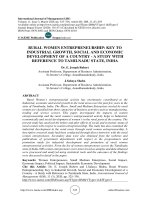Economic growth and economic development 394
Bạn đang xem bản rút gọn của tài liệu. Xem và tải ngay bản đầy đủ của tài liệu tại đây (88.7 KB, 1 trang )
Introduction to Modern Economic Growth
and the transition equation (8.7).
Notice that the transversality condition is written in terms of the current-value
costate variable, which is more convenient given the rest of the necessary conditions.
ˆ (a, c, µ) is a
Moreover, as discussed in the previous chapter, for any µ (t) > 0, H
concave function of (a, c). The first necessary condition (and equation (8.13) below),
in turn, imply that µ (t) > 0 for all t. Therefore, Theorem 7.15 implies that these
conditions are sufficient for a solution.
We can next rearrange the second condition to obtain:
(8.12)
µ˙ (t)
= − (r (t) − ρ) ,
µ (t)
which states that the multiplier changes depending on whether the rate of return
on assets is currently greater than or less than the discount rate of the household.
Next, the first necessary condition above implies that
(8.13)
u0 (c (t)) = µ (t) .
To make more progress, let us differentiate this with respect to time and divide by
µ (t), which yields
µ˙ (t)
u00 (c (t)) c (t) c˙ (t)
=
.
0
u (c (t)) c (t)
µ (t)
Substituting this into (8.12), we obtain another form of the famous consumer Euler
equation:
(8.14)
1
c˙ (t)
=
(r (t) − ρ)
c (t)
εu (c(t))
where
(8.15)
εu (c (t)) ≡ −
u00 (c (t)) c (t)
u0 (c (t))
is the elasticity of the marginal utility u0 (c(t)). This equation is closely related to
the consumer Euler equation we derived in the context of the discrete time problem,
equation (6.30), as well as to the consumer Euler equation in continuous time with
constant interest rates in Example 7.1 in the previous chapter. As with equation
(6.30), it states that consumption will grow over time when the discount rate is less
than the rate of return on assets. It also specifies the speed at which consumption
380









